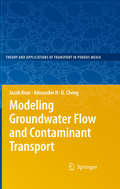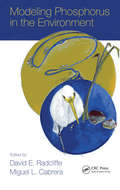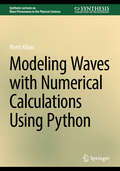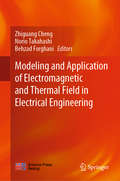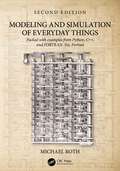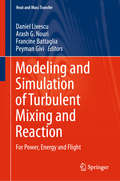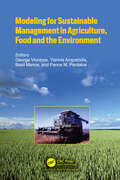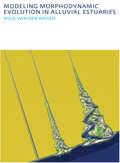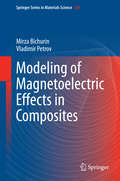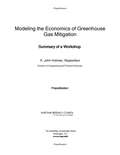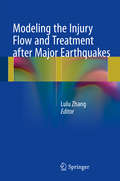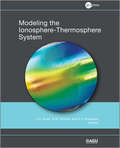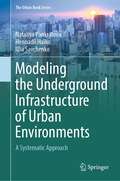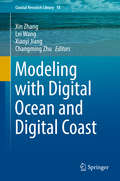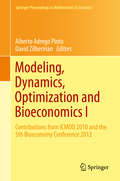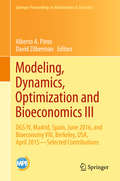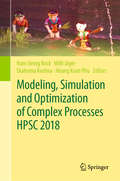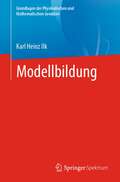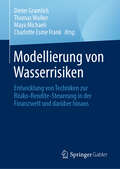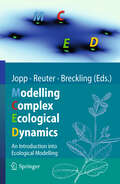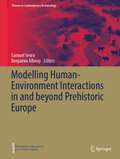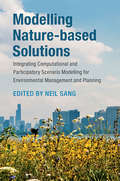- Table View
- List View
Modeling Groundwater Flow and Contaminant Transport
by Jacob Bear Alexander H.-D. ChengIn many parts of the world, groundwater resources are under increasing threat from growing demands, wasteful use, and contamination. To face the challenge, good planning and management practices are needed. A key to the management of groundwater is the ability to model the movement of fluids and contaminants in the subsurface. The purpose of this book is to construct conceptual and mathematical models that can provide the information required for making decisions associated with the management of groundwater resources, and the remediation of contaminated aquifers. The basic approach of this book is to accurately describe the underlying physics of groundwater flow and solute transport in heterogeneous porous media, starting at the microscopic level, and to rigorously derive their mathematical representation at the macroscopic levels. The well-posed, macroscopic mathematical models are formulated for saturated, single phase flow, as well as for unsaturated and multiphase flow, and for the transport of single and multiple chemical species. Numerical models are presented and computer codes are reviewed, as tools for solving the models. The problem of seawater intrusion into coastal aquifers is examined and modeled. The issues of uncertainty in model input data and output are addressed. The book concludes with a chapter on the management of groundwater resources. Although one of the main objectives of this book is to construct mathematical models, the amount of mathematics required is kept minimal.
Modeling Phosphorus in the Environment
by David E. Radcliffe Miguel L. CabreraDespite advances in modeling, such as graphical user interfaces, the use of GIS layers, and databases for developing input files, the approaches to modeling phosphorus (P) have not changed since their initial development in the 1980s. Current understanding of P processes has evolved and this new information needs to be incorporated into the current
Modeling Software: Environmental Hydraulics (Wiley-iste Ser.)
by Jean-Michel TanguyThis series of five volumes proposes an integrated description of physical processes modeling used by scientific disciplines from meteorology to coastal morphodynamics. Volume 1 describes the physical processes and identifies the main measurement devices used to measure the main parameters that are indispensable to implement all these simulation tools. Volume 2 presents the different theories in an integrated approach: mathematical models as well as conceptual models, used by all disciplines to represent these processes. Volume 3 identifies the main numerical methods used in all these scientific fields to translate mathematical models into numerical tools. Volume 4 is composed of a series of case studies, dedicated to practical applications of these tools in engineering problems. To complete this presentation, volume 5 identifies and describes the modeling software in each discipline.
Modeling Volcanic Processes
by Sarah A. Fagents Tracy K. P. Gregg Rosaly M. C. Lopes Sarah A. Fagents Tracy K. P. GreggUnderstanding the physical behavior of volcanoes is key to mitigating the hazards active volcanoes pose to the ever-increasing populations living nearby. The processes involved in volcanic eruptions are driven by a series of interlinked physical phenomena, and to fully understand these, volcanologists must employ various physics subdisciplines. This book provides the first advanced-level, one-stop resource examining the physics of volcanic behavior and reviewing the state-of-the-art in modeling volcanic processes. Each chapter begins by explaining simple modeling formulations and progresses to present cutting-edge research illustrated by case studies. Individual chapters cover subsurface magmatic processes through to eruption in various environments and conclude with the application of modeling to understanding the other volcanic planets of our Solar System. Providing an accessible and practical text for graduate students of physical volcanology, this book is also an important resource for researchers and professionals in the fields of volcanology, geophysics, geochemistry, petrology and natural hazards.
Modeling Waves with Numerical Calculations Using Python (Synthesis Lectures on Wave Phenomena in the Physical Sciences)
by Rhett AllainNumerical calculations (what many call computational physics) is a core tool in modern physics. With numerical methods it’s possible to solve problems that would otherwise be impossible. Most physics students and educators have at least some exposure to the wave equation. It shows up in many different contexts—light, quantum mechanics, and even a simple wave on a string. However, it can be difficult to come up with non-trivial solutions to the wave equation. This text goes through the techniques to create a numerical model of the wave equation starting from the very basics and using free and open source tools such as Python and Web VPython.
Modeling and Application of Electromagnetic and Thermal Field in Electrical Engineering
by Zhiguang Cheng Norio Takahashi Behzad ForghaniCo-authored by an international research group with a long-standing cooperation, this book focuses on engineering-oriented electromagnetic and thermal field modeling and application. It presents important contributions, including advanced and efficient finite element analysis used in the solution of electromagnetic and thermal field problems for large and multi-scale engineering applications involving application script development; magnetic measurement of both magnetic materials and components under various, even extreme conditions, based on well-established (standard and non-standard) experimental systems; and multi-level validation based on both industrial test systems and extended TEAM P21 benchmarking platform. Although these are challenging topics, they are useful for readers from both academia and industry.
Modeling and Simulation of Everyday Things
by Michael RothWith Python, C++, FORTRAN, and a friendly conversational tone peppered with attempted humor, Modeling and Simulation of Everyday Things takes us on a journey through constructing models and simulations of systems and processes in everyday life and beyond. Readers can access an example‑packed online repository of programs in each of the three languages, including seldom covered work in generalized geometries and 3D.This second edition is a wonderful confluence of development of Python and C++ applications and will cultivate a broad perspective in the readership through having translations of major programs available in Python, C++, and FORTRAN (as we move forward, software engineers and researchers are recognizing the value of legacy programming). In addition to leveraging the best of the three languages, the readership can explore versatility in visualization by using native Python graphics as well as POV Raytracer and third‑party animation tools. We approach modeling of a system by introducing the theoretical framework of the system, followed by its discretized form, and then with narrated programs and sample results that also appear in the online repository.Readers will be able to critically think through constructing models and simulations of a vast array of systems, interpreting results, and visualizing them (which includes examples for visually and auditorily impaired individuals). Most importantly, their confidence will propel them forward to meet the challenges of the field and to think "outside the book". Leveraging the best of three coding languages, two tracks for visualization, a conversational tone, and numerous examples, this book is extremely versatile and can be used by students from high school through science undergraduates in 2‑year and 4‑year institutions. The text is also ideal for use in Data Science as well as Professional Science Master’s programs.
Modeling and Simulation of Turbulent Mixing and Reaction: For Power, Energy and Flight (Heat and Mass Transfer)
by Francine Battaglia Daniel Livescu Arash G. Nouri Peyman GiviThis book highlights recent research advances in the area of turbulent flows from both industry and academia for applications in the area of Aerospace and Mechanical engineering. Contributions include modeling, simulations and experiments meant for researchers, professionals and students in the area.
Modeling for Sustainable Management in Agriculture, Food and the Environment
by George VlontzosRecent developments in computer science, data mining and big data analytics have resulted in new operational frameworks in agriculture, food and the environment, which in fact, share a strong link between them. A key challenge for researchers is to extract new data patterns and utilize them in decision making. Managers, policy makers, and practitioners have to be aware of these methodologies in order to establish efficient and effective working groups for the tasks to be resolved. The book reviews the complexity of the interrelationship between agriculture, food production and processing, and environmental issues. It also highlights the prospects of modeling in various cases of problem solving in these sectors, and reviews the new and future challenges. Consumer awareness in food production and processing practices is continually increasing and the necessity for advanced behavioural tools follows the same trend. Furthermore, the value chain management challenge is becoming one of the most crucial tasks due to the increased importance of new parameters like the origin of products, its environmental footprint and the enhancement of local production, etc. The book addresses these topics in a holistic approach, merging modeling with advanced marketing practices in a coherent and innovative manner, being an effective tool in a continuously demanding world.
Modeling morphodynamic evolution in alluvial estuaries (IHE Delft PhD Thesis Series)
by Mick van WegenThe main objective of this research is to investigate the governing processes and characteristics that drive morphodynamic evolution in alluvial estuaries by application of a process-based numerical model (Delft3D). It is of utmost importance to understand estuarine processes so that impact of human interference (like dredging and land reclamation) and long-term changes (like sea level rise) can be evaluated.The research addresses a number of cases ranging from an rectangular basins to real estuaries like the Western Scheldt in the Netherlands or San Pablo Bay in California. The more schematized approach allow to study morphodynamic evolution over several millennia under constant forcing and answers more fundamental questions related to conditions of equilibrium and related time scales. The more realistic cases give insight into the skill of the approach in predicting decadal morphodynamic developments. More processes are included to mimic realistic conditions and model results are compared to bathymetric measurements over the last century.The research shows that the modeling approach is good capable of describing stable morphodynamic calculations over a timescale of millennia with patterns similar to patterns observed in reality. Additionally, the approach shows that it is possible to predict decadal morphodynamic developments in real estuaries with significant skill.
Modeling of Magnetoelectric Effects in Composites
by Mirza Bichurin Vladimir PetrovThis book brings together numerous contributions to the field of magnetoelectric (ME) composites that have been reported so far. Theoretical models of ME coupling in composites relate to the wide frequency range: from low-frequency to microwave ones and are based on simultaneous solving the elastostatic/elastodynamic and electrodynamics equations. Suggested models enable one to optimize magnetoelectric parameters of a composite. The authors hope to provide some assimilation of facts into establish knowledge for readers new to the field, so that the potential of the field can be made transparent to new generations of talent to advance the subject matter.
Modeling the Economics of Greenhouse Gas Mitigation: Summary of a Workshop
by National Research Council of the National AcademiesModels are fundamental for estimating the possible costs and effectiveness of different policies for reducing greenhouse gas (GHG) emissions. There is a wide array of models to perform such analysis, differing in the level of technological detail, treatment of technological progress, spatial and sector details, and representation of the interaction of the energy sector to the overall economy and environment. These differences impact model results, including cost estimates. More fundamentally, these models differ as to how they represent fundamental processes that have a large impact on policy analysis--such as how different models represent technological learning and cost reductions that come through increasing production volumes, or how different models represent baseline conditions. Reliable estimates of the costs and potential impacts on the United States economy of various emissions reduction and other mitigation strategies are critical to the development of the federal climate change research and development portfolio. At the request of the U.S. Department of Energy (DOE), the National Academies organized a workshop, summarized in this volume, to consider some of these types of modeling issues.
Modeling the Injury Flow and Treatment after Major Earthquakes
by Lulu ZhangThis book discuss a series of earthquake emergency medical rescue complex models, which can provide theoretical support for medical disaster rescue work in the future. This book consists of three parts. The first part is an introduction (chapter 1) which makes an overview of the purpose, meaning, methods and relative theory using in the research. The second part (chapter 2 to 8) includes "casualty flow" related factors such as the occurrences of earthquake casualty, the Length of Stay among the Hospitalized Patients, the medical evacuation in earthquake and rescue force related factors such as the medical rescue forces allocation in earthquake, the organization and command of earthquake rescue forces, Location and Distribution of Medical Rescue Institutions and from peacetime to wartime in hospital. The third part (chapter 9) is a summary including conclusion and policy-making suggestion.
Modeling the Ionosphere-Thermosphere (Geophysical Monograph Series #201)
by J. D. HubaPublished by the American Geophysical Union as part of the Geophysical Monograph Series, Volume 201. Modeling the Ionosphere-Thermosphere System brings together for the first time a detailed description of the physics of the IT system in conjunction with numerical techniques to solve the complex system of equations that describe the system, as well as issues of current interest. Volume highlights include discussions of: Physics of the ionosphere and thermosphere IT system, and the numerical methods to solve the basic equations of the IT system The physics and numerical methods to determine the global electrodynamics of the IT system The response of the IT system to forcings from below (i.e., the lower atmosphere) and from above (i.e., the magnetosphere) The physics and numerical methods to model ionospheric irregularities Data assimilation techniques, comparison of model results to data, climate variability studies, and applications to space weather Providing a clear description of the physics of this system in several tutorial-like articles, Modeling the Ionosphere-Thermosphere System is of value to the upper atmosphere science community in general. Chapters describing details of the numerical methods used to solve the equations that describe the IT system make the volume useful to both active researchers in the field and students.
Modeling the Underground Infrastructure of Urban Environments: A Systematic Approach (The Urban Book Series)
by Nataliya Pankratova Hennadii Haiko Illia SavchenkoThe book considers the underground development of cities from a systemic point of view. The authors' scientific methodology for planning a system of alternative design configurations in a metropolis (including underground infrastructure) on the basis of applied system analysis methods is revealed. The book presents a short guide and a number of practical applications of morphological analysis, cognitive modeling, and other system analysis methods as tools for solving various urban problems, including risk assessment in the transport infrastructure of a city; evaluation and justification of constructing different types of underground objects on a selected site according to its structural, functional and geological factors; construction of scenarios aimed at informed decision-making in planning complex underground facilities. The book provides novel and convenient tools for urban development to professionals in urban planning, municipal authorities and investors, and researchers in urban studies.
Modeling with Digital Ocean and Digital Coast
by Xin Zhang Xiaoyi Jiang Lei Wang Changming ZhuThis book presents essential new insights in research and applications concerning spatial information technologies and coastal disaster prevention modeling for oceanic and coastal regions. As a new research domain of Digital Earth, it covers the latest scientific and technical advances, from the acquisition and integration of observational data, ocean spatio-temporal analysis and coastal flood forecasting to frequency modeling and the development of technical platforms. The individual chapters will be of interest to specialists in oceanic and coastal monitoring and management who deal with aspects of data integration, sharing, visualization, and spatio-temporal analysis from a Digital Earth perspective.
Modeling, Dynamics, Optimization and Bioeconomics I
by David Zilberman Alberto Adrego PintoThis volume explores the emerging and current, cutting-edge theories and methods of modeling, optimization, dynamics and bio economy. It provides an overview of the main issues, results and open questions in these fields as well as covers applications to biology, economy, energy, industry, physics, psychology and finance. The majority of the contributed papers for this volume come from the participants of the International Conference on Modeling, Optimization and Dynamics (ICMOD 2010), a satellite conference of EURO XXIV Lisbon 2010, which took place at Faculty of Sciences of University of Porto, Portugal and from the Berkeley Bio economy Conference 2012, at the University of California, Berkeley, USA.
Modeling, Dynamics, Optimization and Bioeconomics III: Contributions From Dgs Iii And The 7th Bioeconomy Conference 2014 (Springer Proceedings in Mathematics & Statistics #195)
by David Zilberman Alberto A. PintoThe research and review papers presented in this volume provide an overview of the main issues, findings, and open questions in cutting-edge research on the fields of modeling, optimization and dynamics and their applications to biology, economics, energy, finance, industry, physics and psychology. Given the scientific relevance of the innovative applications and emerging issues they address, the contributions to this volume, written by some of the world’s leading experts in mathematics, economics and other applied sciences, will be seminal to future research developments and will spark future works and collaborations. The majority of the papers presented in this volume were written by participants of the 4th International Conference on Dynamics, Games and Science: Decision Models in a Complex Economy (DGS IV), held at the National Distance Education University (UNED) in Madrid, Spain in June 2016 and of the 8th Berkeley Bioeconomy Conference: The Future of Biofuels, held at the UC Berkeley Alumni House in April 2015.
Modeling, Simulation and Optimization of Complex Processes HPSC 2018: Proceedings of the 7th International Conference on High Performance Scientific Computing, Hanoi, Vietnam, March 19-23, 2018
by Willi Jäger Hans Georg Bock Hoang Xuan Phu Ekaterina KostinaThis proceedings volume highlights a selection of papers presented at the 7th International Conference on High Performance Scientific Computing, which took place in Hanoi, Vietnam, during March 19-23, 2018. The conference has been organized by the Institute of Mathematics of the Vietnam Academy of Science and Technology, the Interdisciplinary Center for Scientific Computing (IWR) of Heidelberg University and the Vietnam Institute for Advanced Study in Mathematics. The contributions cover a broad, interdisciplinary spectrum of scientific computing and showcase recent advances in theory, methods, and practical applications. Subjects covered include numerical simulation, methods for optimization and control, machine learning, parallel computing and software development, as well as the applications of scientific computing in mechanical engineering, airspace engineering, environmental physics, decision making, hydrogeology, material science and electric circuits.
Modellbildung (Grundlagen der Physikalischen und Mathematischen Geodäsie)
by Karl Heinz IlkDieses Lehrbuch aus der Reihe „Grundlagen der Physikalischen und Mathematischen Geodäsie“ behandelt die wesentlichen Aspekte einer geodätischen Modellbildung im Rahmen der Physikalischen und Mathematischen Geodäsie. Dabei geht der Autor auf die dreidimensionalen Modellbildungen ein und betrachtet die Transformationen zwischen verschiedenen Koordinatensystemen. Zweidimensionale Modellbildungen erläutert der Autor ausgehend von den Abbildungen auf eine Kugel, um die Erkenntnisse dann auf den in der Anwendung wichtigen Fall des Rotationsellipsoides zu übertragen. Die Leser lernen Transformationsmethoden zwischen den verschiedenen Abbildungen kennen, die trotz der Entwicklung moderner Satellitennavigationssysteme zum Grundwissen der Geodäsie gehören. Große Bedeutung haben die eindimensionalen Modellbildungen der Höhen: Der Autor erläutert die wichtigsten Höhensysteme, die Transformation zwischen den Höhensystemen und die Problematik der Vertikaldatumsfestlegung.
Modellierung von Wasserrisiken: Entwicklung von Techniken zur Risiko-Rendite-Steuerung in der Finanzwelt und darüber hinaus
by Thomas Walker Dieter Gramlich Maya Michaeli Charlotte Esme FrankDieses Buch beleuchtet das Thema finanzielles Wasserrisiko, indem es die Modellierungs-Herausforderungen untersucht, die mit physischem, regulatorischem und Ruf-bedingtem Wasserrisiko in der Finanzwelt verbunden sind. Es erkundet verschiedene Ansätze zur Operationalisierung von Wasserrisiken aus finanzieller Analyse, Investmentmanagement und Klimawissenschaft. Die Analyse von Instrumenten zur Bewertung von Wasserrisiken bildet die Grundlage für die Entwicklung geeigneter Risiko-Rendite-Steuerungstechniken in der Finanzbranche und darüber hinaus. Dieses Buch liefert neue Einblicke, indem es sich auf finanzielle Wassergefahren und die damit verbundenen Chancen konzentriert. Es wird sowohl für Wissenschaftler als auch Praktiker von Interesse sein, die an der Schnittstelle von Finanzen, Wirtschaft, Natur und Gesellschaft tätig sind.
Modelling Atomic Arrangements in Multicomponent Alloys: A Perturbative, First-Principles-Based Approach (Springer Series in Materials Science #346)
by Christopher D. WoodgateThis book provides a comprehensive overview of a computationally efficient approach for modelling the phase behaviour of multicomponent alloys from first principles, describing both short- and long-range atomic ordering tendencies. The study of multicomponent alloy systems, which combine three or more base elements in near-equal ratios, has garnered significant attention in materials science due to the potential for the creation of novel materials with superior properties for a variety of applications. High-entropy alloys, which contain four or more base elements, have emerged as a particularly fascinating subset of these systems, demonstrating extraordinary strength and fracture resistance, among other desirable properties. The book presents a novel modelling approach for studying the phase behaviour of these systems, which is based on a perturbative analysis of the internal energy of the disordered alloy as evaluated within the Korringa–Kohn–Rostoker (KKR) formulation of density functional theory (DFT), using the coherent potential approximation (CPA) to average over chemical disorder. Application of a Landau-type theory to an approximate form of the Gibbs free energy enables direct inference of chemical disorder/order transitions. In addition, the perturbative analysis facilitates extraction of atom-atom effective pair interactions for further atomistic simulations. The connection between the arrangement of atoms in a material and its magnetic properties is also studied. By outlining and applying the proposed modelling techniques to several systems of interest, this book serves as a valuable resource for materials scientists, physicists, and chemists alike, seeking to understand and develop new alloy systems with enhanced materials properties.
Modelling Complex Ecological Dynamics
by Donald Deangelis Hauke Reuter Broder Breckling Melanie Trexler Sven Erik Jørgensen Fred JoppModel development is of vital importance for understanding and management of ecological processes. Identifying the complex relationships between ecological patterns and processes is a crucial task. Ecological modelling--both qualitatively and quantitatively--plays a vital role in analysing ecological phenomena and for ecological theory. This textbook provides a unique overview of modelling approaches. Representing the state-of-the-art in modern ecology, it shows how to construct and work with various different model types. It introduces the background of each approach and its application in ecology. Differential equations, matrix approaches, individual-based models and many other relevant modelling techniques are explained and demonstrated with their use. The authors provide links to software tools and course materials. With chapters written by leading specialists, "Modelling Complex Ecological Dynamics" is an essential contribution to expand the qualification of students, teachers and scientists alike.
Modelling Human-Environment Interactions in and beyond Prehistoric Europe (Themes in Contemporary Archaeology)
by Samuel Seuru Benjamin AlbouyThis book offers insight into the relationship between prehistoric and protohistoric human populations and the world around them. It reconstructs key aspects of the palaeoenvironment – from large-scale drivers of environmental conditions, such as climate, to more regional variables such as vegetation cover and faunal communities. The volume underscores how computational archaeology is leading the way in the study of past human-environment interactions across spatial and chronological scales. With the increased availability of high-resolution climate models, agent-based modelling, palaeoecological proxies and the mature use of Geographic Information System in ecological modelling, archaeologists working in interdisciplinary settings are well-positioned to explore the intersection of human systems and environmental affordances and constraints. These methodological advancements provide a better understanding of the role humans played in past ecosystems – both in terms of their impact upon the environment and, in return, the impact of environmental conditions on human systems. They may also allow us to infer past ecological knowledge and land-use patterns that are historically contingent, rather than environmentally determined. This volume gathers contributions that combine reconstructions of past environments and archeological data with a view to exploring their complex interactions at different scales and invites scholars from varying disciplines and backgrounds to present and compare different modelling approaches.
Modelling Nature-based Solutions: Integrating Computational and Participatory Scenario Modelling for Environmental Management and Planning
by Neil SangNature-based solutions (NBS) are essential to ensure a sustainable society and healthy ecosystem over the coming decades. However, the systems to be managed are both broad and complex, requiring an integrated understanding of both bio-physical systems, such as soils and water, and economic and social systems, such as urban development and human behaviour. This edited book joins these domains of knowledge together from an applied perspective and considers how computer science can help. It takes a strategic look at the benefits and barriers to using modelling within environmental management and planning practice. It delves further by providing an in-depth comparative review of a wide range of models from a variety of scientific disciplines of interest with examples of their use for NBS. As such, this illustrated guide is designed to help students, researchers and practitioners navigate the huge range of modelling options available and develop the common understanding to work inter-disciplinarily.
